#jacobite uprising 1745
Text
It's both funny and sad seeing online (and in this case anonymous) "journalists" scrambling to get a hold on who "redcoats" are in the wake of a recent inflated faux outrage about a café in Edinburgh. This article in particular is a wild one.
"The uniform was used by British soldiers from the 16th to 19th century in several conquests on behalf of the the British military around the world."
No, unless we're counting some niche Scottish and English retinues in the 16th c. it was used from the 1640s by the English and the 1660s by the Scottish (almost half a century before the Act of Union). Nor did the uniform stop being worn in the 19th century, it only ceased being battlefield dress - it's still ceremonially worn today (by Scottish regiments as well).
"For those unaware (take note, Edinburgh Castle), from 1725 onwards, garrisons manned by government soldiers or "redcoats" sprung up all over the Scottish Highlands, most notably at Fort William and Inverness."
I love the condescending tone of this part, with the anon author totally schooling Historical Environment Scotland for their lack of history knowledge. But no, garrisons didn't suddenly start appearing from 1725 onwards. Prior to 1745 Scotland was not an "occupied" country. The redcoats being talked about were mostly Scottish regiments holding the Scottish garrisons they'd occupied for decades (the basic problem with the premise of this article is people think "redcoat" = "English." Ironically for at least half of the historical timeframe the English were a minority of "redcoats").
"Redcoats took an aggressive hand to Scots across the country who did not support the king and attempted to cling to their national identity."
Which king? The exiled Stuart king? The "Hanoverian" king? This "national identity" stuff is also fabricated hokum, again, there was no effort at repression in Scotland by "redcoats" prior to the 1745 uprising, just the usual service performed by the 18th c. military. Scotland had one of the lowest ratios of soldiers-to-population in Europe during the period! These soldiers were almost all Scottish themselves. The author is just writing what they vaguely think is the case as fact.
"The government army, clad in red, massacred Scots at the Battle of Culloden Moor, marking not only the defeat of the Jacobite movement, but the destruction of clan and Gaelic Highland life. From 1745, Highlanders were forbidden to carry weapons – including the famous broadsword. The playing of the bagpipes was banned. Tartan and highland dress was outlawed."
The clan structure was dying a death before Culloden and the battle didn't mark its final "destruction" (people seem to also think the redcoats were responsible for the Clearances, so at this stage anything's fair game). The bans on the things mentioned as outlawed were barely enforced and largely repealed within a few decades.
"And clansmen who dared to defy? Fines, imprisonment, exile, and death at the hands of... you guessed it, the redcoats. However, as one user wrote, "history is complex", highlighting that Scots wearing redcoats were on the side of the British army on the moor."
They finally managed to mention that "redcoats" aren't just the English. In fact most of the "fines, imprisonment, exile and death" being meted out was by fellow Scots against the Jacobites, who didn't have the support of the majority of the country. And this wasn't just a lowlanders vs highlanders thing, highlanders were behind repressing *other* highlanders, as has been the case throughout history.
The best part of all this is the café has been operating under that name for 32 years without comment, but they've only just noticed so now it's become a thing.
tl;dr

33 notes
·
View notes
Text

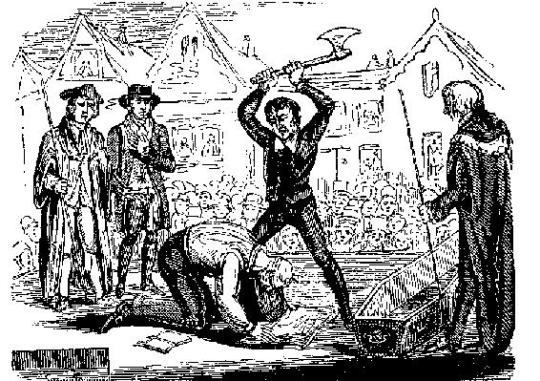
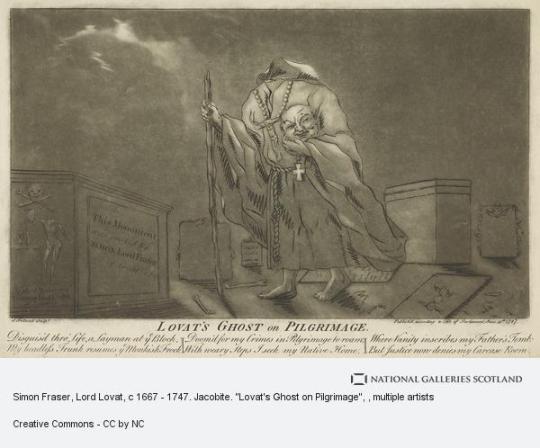

On 9th April 1747 Simon Fraser, Lord Lovat, the leading Scottish Jacobite rebel was beheaded on Tower Green.
A longer post than normal from me as in my opinion Simon Fraser was one of the most interesting characters in Jacobite history. A man of contrary, he was known to be very kind to the lesser clansmen taking a paternal interest in their affairs. A quote regarding him says that….“Generally he had a bag of farthings for when he walked abroad the contents of which he distributed among any beggars whom he met. He would stop a man on the road; inquire how many children he had; offer him sound advice; and promise to redress his grievances if he had any”
In his own estimate, he took care his clansmen were ‘always well-clothed and well-armed, after the Highland fashion, and not to suffer them to wear low-country clothes’ Lovat was also a brute of a man forcing a young woman into marriage and raping her in an attempt to legitimise the union. Lovat has become more well know lately thanks to Outlander, where in their world he is grandfather to the main protagonist Jamie Fraser and played brilliantly by the fine Scottish actor Clive Russell. Back in the real world he has been in the news in the recent past, I shall cover that at the end of this post.
Born in 1667 into the ancient clan who fought with distinction in the Wars of Independence – Sir Simon Fraser was one of the co-victors of the Battle of Roslin and his sons were close friends of Robert the Bruce, Alexander marrying Bruce’s sister Mary – Simon was the second son of Thomas Fraser of Beaufort who was closely related to Lord Hugh Fraser of Lovat, chief of clan Fraser.
Simon became his father’s heir when his elder brother was killed fighting alongside Bonnie Dundee against the forces of King William III at the Battle of Killiecrankie in 1689. He was still nowhere near being clan chief, however, and took himself off to Aberdeen University from which he graduated in 1695. Lord Hugh Fraser, the 9th Lord Lovat, was a weak man who unexpectedly signed over the clan leadership to Simon’s father in 1696.
Lord John Murray, Earl of Tullibardine and the most powerful man in Scotland, disputed the succession and fell out spectacularly with Simon in Edinburgh. The young Fraser hothead duly went north to Castle Dounie to try and persuade Hugh’s widow Amelia to give him the hand of her daughter, also Amelia, in a dynastic marriage that would seal his succession. Tullibardine was having none of it and moved his niece to the Murray stronghold, Blair Castle, where he planned to marry her off to Alexander Fraser, heir to the Lordship of Saltoun.
Simon retaliated by kidnapping Alexander and frightening him away, and to make matters worse in October, 1697, he went back to Castle Dounie and forced the widow Amelia into a sham wedding, raping her to consummate the “marriage”.
Tullibardine ensured Simon and his father were declared outlaws and when old Thomas died in 1699, Simon was unable to legally claim his title as 11th Lord Lovat which later passed to one Alexander Mackenzie who had legally married the younger Amelia.
Simon Fraser somehow managed to persuade King William that he was no threat, despite having his own personal army, and he was pardoned in 1700, only to be declared an outlaw again the following year over the forced marriage and rape.
Simon went off to the court of the Stuarts in France where he devised the plans that were eventually used in the 1715 and 1745 uprisings. Long before the former, however, Simon was double dealing, giving Queen Anne information about the plans of James, the Old Pretender. He was found out and King Louis XIV clapped him in jail for three years.
Even after he was released he was prevented from travelling to Scotland and thus missed the Act of Union which he opposed.
Still desperate to get his Lovat title and the chieftainship of his clan back, Simon sided with the forces of the new King, George I, during the ’15, and was given back his title as a reward, with Alexander Mackenzie imprisoned for being a Jacobite. The two men would fight in the courts for the next 15 years as to who was entitled to the income of the estate. Simon eventually won and spent his time building up the Fraser estates and wealth, even taking command of one of the Independent Companies of Highland soldiers established by the Hanoverian regime – the Fraser Highlanders.
As I said early Fraser was a man of contrary and to me was very like “Bobbing John” The Earl of Mar another Jacobite who a tendency to shift back and forth from faction to faction, no sooner had Fraser built up this “Hanoverian” army that he started openly campaigning for the restoration of the Stuarts. The Government responded by cancelling his military role.
When Bonnie Prince Charles landed in Scotland he was still playing games.
He allowed his sons to fight for the Stuarts, but stayed at home himself “loudly lamenting the wilful disobedience of children,” as Sarah Fraser has put it. Lovat did meet Charles, however, and expressed his anger at the lack of “siller” which he knew would be necessary for a successful campaign. They met again after Culloden, at which Clan Fraser fought bravely and suffered many casualties, and Lovat advised the prince to get away and re-form his forces. Charles fled through the heather, as we know, and made it to France while anyone associated with the Bonnie Prince was hunted down. The Duke of Cumberland’s troops were not taking any more games from Fraser and burned Castle Dounie.
Lovat managed to make it to Loch Morar but was captured there while hiding in a hollow tree. Although approaching his 80th birthday, The Fox was taken south to London.
He pled not guilty but his trial was a formality and he must have know his fate would be the same as previous nobles, the Earls of Kilmarnock, Balmerino and Derwentwater who were executed for treason the previous year.
At his trial, ever the Fox he insisted strongly upon his affection for the reigning family. Such were the characteristics of Simon Fraser, but of course he was found guilty the sentence, hanging, drawing and quartering was commuted later to a mere beheading by the King.
In a way, Lovat had the last laugh. Newspapers and pamphlets of the time recorded that as he was led out to the scaffold on Thursday, April 9, 1947, a wooden stand that had been erected near the Tower to seat crowds eager to see the execution collapsed sending hundreds plunging down. At least nine people died and dozens were injured, which amused Lovat – the phrase ‘laughing your head off’ is said to date from that event.
According to a woodcut print made on that fateful day, Lovat “with some composure laid his head on the block which the executioner took off with a single blow.”
As I mentioned at the top Lovat has been in the news quite recently. Simon had requested burial at the family mausoleum at Wardlaw near Inverness and the government initially agreed but changed its mind thinking his body could become a rallying point for further trouble. He was therefore buried in the floor of the chapel within the Tower of London, St. Peter ad Vincula. The chapel was refurbished in the 19th century and the floor was relaid. One of the coffins uncovered during the works had the nameplate of ‘Lord Lovat’. The names of those found are now recorded on a plaque on the wall of the chapel.
Fraser folklore, and written in several books says that his body was spirited away from London, the stories even go so far as to name the boat ‘The Pledger’ that sailed north to The Beauly Firth, where he was taken to the family mausoleum, there is even a plaque in the crypt that reads “In this coffin are laid the remains of Simon Lord Fraser of Lovat who, after twenty years in His own Land and abroad with the greatest distinction and renown, at the risk of his own life, restored and preserved his race, clan and household from the tyranny of the Athol and the treacherous plotting of the Mackenzies of Tarbat. To preserve an ancient house is not the greatest credit. Nor is there any honour for the enemy who despoiled it. Although that enemy was strong in his plotting and unrelenting warfare, yet Simon who was also skillful and cunning defeated him in war.“
In 2018 the headless skeleton inside the coffin was exhumed to be examined by experts from the University of Dundee in January this year they announced that the bones in the coffin did not belong to Simon Fraser, but to a young woman. So it looks like his body did end up rotting in The Tower’s Chapel, although the Frasers will still tell you otherwise.
Scottish actor Clive Russell played The Old Fox in the television adaptation off Outlander.
14 notes
·
View notes
Text
I fucking hate writing fanfiction, I'm just trying to make these idiots kiss and suddenly I'm researching the Jacobite uprising of 1745
20 notes
·
View notes
Note
Dude dude dude. Wdym you know lots about Cornish history. Please share. I want this info dump. I want to know more. I will beg on my knees if necessary.
!!!!
I guess it depends on which period of Cornish history you wanna know about! I admit I don’t know a great deal about say Dunmonia or the really properly ancient culture in Cornwall. I take more of an interest in the social and industrial side of Cornish history. But I can give you a run-down of some parts of Cornish history you’ll never shut me up about!
The Cornish Jacobites and their rebellion in 1715! It actually had an impact on the 1745 rebellion, as well, as one of the Cornish Jacobite leaders’ (who was tossed in Newgate prison) family were suspected of harbouring Prince Charles Stuart, though it’s unlikely this did in fact occur. Actually this whole period is really interesting!
Cornwall during the French Rev wars!! So actually. In Cornwall, the ideas of Liberté, égalité, fraternité we’re quite popular. So popular in that in St. Just which was on the Tin Coast, a group of men planted a Liberty Tree. There was also a great deal of economic struggle (Cornwall has always been one of the poorest regions in the UK, however it was particularly drastic at this time, so much so that if you were a working family, you’d likely not be able to afford wheat for bread as it was extraordinarily highly priced). In fact, the officials of the area feared an uprising. I don’t have the number off the top of my head, but the reason they feared an uprising in Cornwall so much was because they’d be extremely outnumbered. Like I said, don’t have the precise number but it would’ve been a blood bath. Though luckily enough, the wars would very soon come to an end. Until the Napoleonic Wars kicked off.
Cornwall during the Napoleonic Wars is just. I could write a book or a very, very long essay. It’s also a very important time for industry. However Cornwall also held a unique position, being so close to France. French refugees trying to flee the war would be snuck across the channel and into Cornwall. They would also be given English names and set up with work. Not official, by the way. This wasn’t exactly a government approved activity. However there were also a few prisoner of war camps in Cornwall, a notable one in Roskrow. Detectorists must have a blast there… I’m also extremely emotional about one Captain James Quick, a St. Ives merchant captain who was taken a prisoner of war after setting sail from Falmouth and his ship, the Hopewell, becoming extremely damaged, losing all sails and being driven to the French coast and grounded in November 1810. He married his wife in just September. I actually have read the letters he wrote to his wife Harriett during this time and Christ. It’s a hell of a thing. He eventually made it home in 1814.
Industry in Cornwall is something I’ve touched on already a bit. But mining, fishing and farming were the biggest. And there’s the technology developed for it. One day I’ll need to talk in depth about the submarine mines, specifically Levant Mine (though it is a truly horrific story). Levant was actually 600 meters deep and before the “man engine” men and boys would have to climb around 80 sets of ladders up and down every single day, twice a day, in extremely hot mines that, at their longest stretched a mile beneath the sea floor. It wasn’t uncommon for men to just pass out from exhaustion on the ladders. A beam engine was introduced, which is still there. The only one in Cornwall.
By WWI, Cornwall has been pretty well established as a major entryway for trade into and out of the UK. Falmouth was THE port of call for ages. However, there was something called spy mania. Officials were worried German spies may use Cornwall to get into the country. This led to mass incarcerations of “spies” (many of whom were proven innocent) and subsequent executions. However even if you weren’t a spy, people coming into the country could be detained, thrown into a jail/workhouse and then drafted against their will into the war. It would have been a horrifying time to try and come into the country. On the topic of world wars and Cornwall, there are some places — one, I actually believe around Falmouth — where coastal defences managed to sink German uboats and at low tide you can even walk out to them (or at least they become exposed enough you can clearly make them out).
Once the tin and copper dried up, many Cornish miners were told they could have free land in places like Australia (and if this sounds a bit like what the US government told labourers in the mid 19thc, well it’s a theme). Besides Australia, many MANY miners also went to North America. In Mexico there’s even a town called Real de Monte, sometimes called “Little Cornwall” for its Cornish heritage there. Some Cornish miners also went as far West into America as California — again, which has a number of Cornish names about — and into the Appalachians and all along the east coast. The Hoosac Tunnel Disaster in 1853 was heavily being worked by Cornish immigrants and took over 20 years to complete.
I’ve not even touched on the language and the rebuilding thereof, nor cultural history or festivals. Or the smuggling!!! Or the civil war!!! Or it’s number of rebellions!! As I say, it really depends on which era and what aspect of Cornish history you’d be interested in learning about! I just kinda did a quick play by play, highlights! I highly recommend going to Kresen Kernow’s website (archives in Redruth) as well as the Royal Cornwall Museum which has quite a few digitised records in their online archives. Bodmin War Museum and the Falmouth Maritime Museum are also very useful! And if you ever go to Cornwall, PLEASE go to the local museum! You won’t believe the kind of things the volunteers will tell you or the absolute wild history of some of the objects. I can also recommend some reading, too.
#please don’t beg on your knees#I will happily always talk Cornish history#I’m just shy lol#anyways YEA!! there’s A LOT of history here and while I have my own specific areas of interest I did want to cast a wide net lol#pls feel free to ask me about anything here#gonna get sad thinking about James Quick brb#thanks for the ask!!!!!#<33333
6 notes
·
View notes
Text
Stuff I wished was on the button house archives timeline:
Death of Jesus
Birth of Prophet Muhammad
Birth of Buddha (Siddhartha Gautama)
Declaration of independence 
Abolishment of slavery in UK and US
Pocahontas meets King James VI and I
Lewis and Clark expedition
American Civil War
Various Latin American countries declare independence
The Nakba
The troubles 
7 years war
1745 Jacobite uprising
9/11
Peterloo massacre
Hand over of Hong Kong
AIDS epidemic 
While it did mention the fall of the Berlin Wall, what some young people may not know that in the same year, the Tiananmen Square massacre took place.
6 notes
·
View notes
Text

Edward Waverley, the Friend of the Sons of Ivor
'Callum,' said the Chief, 'call Shemus an Snachad' (James of the Needle). This was the hereditary tailor of Vich lan Vohr. 'Shemus, Mr. Waverley is to wear the cath dath (battle colour, or tartan); his trews must be ready in four hours. You know the measure of a well-made man—two double nails to the small of the leg—'
'Eleven from haunch to heel, seven round the waist. I give your honour leave to hang Shemus, if there's a pair of sheers in the Highlands that has a baulder sneck than her's ain at the cumadh an truais' (shape of the trews).
'Get a plaid of Mac-Ivor tartan and sash,' continued the Chieftain, 'and a blue bonnet of the Prince's pattern, at Mr. Mouat's in the Crames. My short green coat, with silver lace and silver buttons, will fit him exactly, and I have never worn it. Tell Ensign Maccombich to pick out a handsome target from among mine. The Prince has given Mr. Waverley broadsword and pistols, I will furnish him with a dirk and purse; add but a pair of low- heeled shoes, and then, my dear Edward (turning to him), you will be a complete son of Ivor.'
…
Our hero having now fairly assumed the 'garb of old Gaul,' well calculated as it was to give an appearance of strength to a figure which, though tall and well-made, was rather elegant than robust, I hope my fair readers will excuse him if he looked at himself in the mirror more than once, and could not help acknowledging that the reflection seemed that of a very handsome young fellow. In fact, there was no disguising it. His light-brown hair—for he wore no periwig, notwithstanding the universal fashion of the time—became the bonnet which surmounted it. His person promised firmness and agility, to which the ample folds of the tartan added an air of dignity. His blue eye seemed of that kind,
Which melted in love, and which kindled in war;
and an air of bashfulness, which was in reality the effect of want of habitual intercourse with the world, gave interest to his features, without injuring their grace or intelligence.
'He's a pratty man, a very pratty man,' said Evan Dhu (now Ensign
Maccombich) to Fergus's buxom landlady.
'He's vera weel,' said the Widow Flockhart, 'but no naething sae weel-far'd as your colonel, ensign.'
-Sir Walter Scott, Waverley, or ‘Tis Sixty Years Since
I’ve wanted to do a series of portraits, for a long time, where I bring to life characters from novels I like based on their descriptions in the books, and now I’ve done my first one—Edward Waverley, the main character of Sir Walter Scott’s first novel, Waverley, an English gentleman who sided with Bonnie Prince Charlie in the Jacobite Uprising of 1745. In the course of his adventures, he befriends Fergus MacIvor, the chief of the Clan MacIvor, and gets adopted into the clan. For the rest of his life and beyond, he was known amongst the Highlanders as the “Friend of the Sons of Ivor.”
Here’s an alternate version without the plaid, so the rest of his outfit can be seen:

#sketch#colored sketch#cartoon#cartoon characters#fanart#sir walter scott#waverley#edward waverley#character art#Novel Portraits#Scottish highlands#trews#Broadsword#tartan#clan macivor#The friend of the sons of Ivor
4 notes
·
View notes
Photo
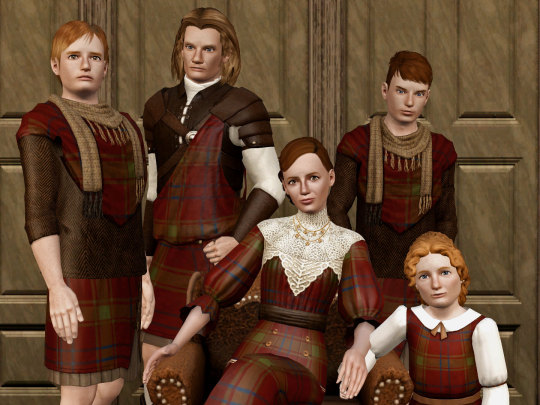
Fiona’s family shortly before 1745. Been wanting to show them for a while - they only appear in narrations.
Matthew Kennaugh senior was a stern but well-respected patriarch, who was closely involved in preparing the Jacobite uprising. He was often away or even abroad on political missions. Fiona only saw him occasionally and they weren’t personally close, but she did look up to him.
During her first childhood, Fiona’s closest companion was her mother - the legendary Rebecca who is always mentioned by Aunt Morgan. (I kinda named her Rebecca because she never appears in the story, but everyone goes on about how awesome she was). Rebecca Kennaugh died of an illness shortly before the uprising took place. Otherwise she might have kept Fiona with her and taken refuge at her sister’s later on. She was a little bit like Agnes Lochinvar, with whom she was on friendly terms.
Matthew jr (red-haried) and Robert (brunette) were lucky enough to survive the battle of Culloden and are currently building up a new existence in the New World. After Fiona sent their mother’s jewellery, they had the funds to really make a new start as farmers. They’re both married now - Fiona once mentioned her mother’s other grandchildren. Matthew actually looks a bit like his namesake. Too bad that it’s highly unrealistic they should ever meet.
Fiona has slightly nostalgic views about her parents - in fact there would have been a lot of extra drama if they’d been around. They wouldn’t have been thrilled about her marrying a very young man of “Government” background, and even less so about Matt. Both Matthew Kennaughs would probably have vetoed him being named after them. (But, this being the family name, I wonder if there’s a fourth little Matthew running around in the New World...) However, I think Fiona would have convinced them in the end.
48 notes
·
View notes
Note
Quite possibly a stupid question, but what is The Flight of The Heron? And if something literary and/or cinematic in nature, where can one find it?
the flight of the heron is a 1925 swashbuckler novel set during the jacobite uprising of 1745, and follows two men from either side of the conflict as they meet and re-meet over a year of war, as their acquaintance as enemies evolves into a friendship...
actually, let me just hit the high points for you: lovingly and extensively described landscapes! duty and honor, and the conflicts resulting from said adherence to duty and honor! a great deal of homoeroticism! extensive historical research put to excellent use! dramatic swordfights! a significant amount of hand-holding! prophecy! tragedy! love? love!!
I'm not a terribly confident explainer, so I shall link you to another explanation as well, which is both more detailed and more amusing. but what I can give you here are links to the ebook and the audiobook!
#answers from the cupola#heronposting#hope this helps... I am just a guy who draws silly little pictures on the internet and not the best with summaries :/#this book has been eating my brain for five months and yet I still have very few words to put around it
33 notes
·
View notes
Note
30
30 days!!!! I straight up forgot to post any gun facts so quick fire round:
46 BC was the last year of the pre-Julian Roman calander and therefore the longest calander year on record
"The '45" refers to the 1745 Jacobite Uprising in Great Britain launched by Charles Stuart in an attempt to take the throne from his father
44 is the atomic number for ruthenium
43 muscles are required to frown
In Egyptian mythology, 42 questions are asked of a person making their journey through death
A 41-gun salute is used for special occasions in the UK
-40 or "40 below" is the only temperature at which Celsius and Fahrenheit are the same
39 was the number of lashes (probably) administered to Jesus Christ as punishment for heresy
An American roulette wheel has 38 slots
If you ask a person to think of a number between 1-50, one out of three people pick 37
In the UK, a standard beer barrel holds 36 gallons
35 is not an even number
There are 34 islands in the Mediterranean
There are 33 letters in the Russian alphabet
The Meisser 32 galaxy is a magnitude 9, dwarf galaxy in the andromeda constellation. Its approximately 2.65 mil light years away, which is fortunate really bc it contains a supermassive black hole
Baskin Robbins always has 31 different flavours avaliable at any one time
Cats have 30 teeth
1 note
·
View note
Note
Hey Tag I had a question about your new fic The Same Cloth! I know bare minimum about Scottish history and with full honesty barely know what a Jacobite is or means and wondered what this line “ “The Hanoverian loyalists would kill ye just for bein’ caught with me, and the Jacobites would kill ye for not wearing Charles’ ribbon and anyone else north of Stirling would kill ye just for bein’ an English spy.” meant specifically?
Yeah for sure! I apologize in advance for the length and depth of the answer I’m fixing to give I promise this was short as I could manage lol So in 1689 The Glorious Revolution happened,which was the removal of King James VII or II depending how you look at it,from the English and Scottish and Irish thrones. James was a Stuart,and the Stuarts had been the rulers of Scotland for 300 years by this point. James’ daughter Mary technically was the one in succession,but it was her husband William of Orange,who ascended the throne in a coup. William was Dutch and Protestant and it was considered not just a coup but a foreign invasion and rule by many,not just in Scotland.
In Scotland specifically,where Catholicism was still very prevalent, many nationalist Scots who wanted a Scottish ruler from a Scottish family,and who was catholic,vehemently opposed the Hanoverian succession. The supporters of the prior Stuart line and opposers to succession of Mary & William were called Jacobites. There were several Jacobite rebellions through the 1700s but the major ones with the most amount of support and which gained the most traction were the rebellions of 1715 and 1745.
The major differences to remember between these rebellions and the evolution of the Jacobites over half a century,is that in 1715 Jacobites were primarily fighting because they were pro Stuart and were catholic nationalists. By 1745 being a Jacobite didn’t necessarily mean you were pro Stuart,when the Deposed King James and his son James (Bonny Prince Charlie) had been living in France for decades. James Charles Stuart,the successor of the Stuart line was entirely raised and thought of as French,not Scottish,and was thought by many to be a lousy option for a ruler. So the Jacobites in 1745 weren’t necessarily for the Stuarts,they were mostly just against Hanoverian rule. Many Jacobites by this point too, were not catholic,but actually Protestants.
But Anakin has landed in Scotland of 1743,before Charles Stuart invades Scotland and the true Jacobite uprising begins. But at this point support and money are being drummed up,and there’s especially a lot of dissent and stirrings of rebellion in the Highlands and Islands,where there is far more Scottish nationalism and resistance to non Scottish rule. That line is referring to the division of loyalties in the highlands that Anakin has stumbled into. Hanoverian supporters would of course be motivated to fight and turn in people thought to be Jacobite rebels, and extremist Jacobite supporters would do the same to a Hanoverian supporter in their midst.
The ribbon reference is to the fact that Jacobites wore a specific ribbon on their bonnets to signify loyalty to Charles Stuart. The conception that specific tartans were for individual clans or families actually didn’t come about until 1800 and wasn’t a thing at this point. A clan chieftain or ruler might favor a specific tartan woven in their county and so defacto be worn by their followers as a sign of loyalty,but that was far from across the board and universal. Jacobites wouldn’t have worn a specific tartan,but a specific ribbon as a form of military insignia.
And as far as the anyone north of Stirling thinking he’s an English spy, Stirling is considered to be the gateway to the Scottish highlands. Stirling is the division of lowlands and mountains,and north of Stirling is where,especially during this period,you saw a clearer division between traditionalist Gaelic culture and the more Anglicized culture of the lowlands. Gaelic Scots still very much despised the English at this point,while with lowlanders you saw those sentiments far less and with far less passion. Hope that helps!
19 notes
·
View notes
Text
Info about Clan MacLeod for Crowley and Rowena enjoyers, courtesy of your local Scot
I thought it might be helpful to make this post for creators interested in exploring Crowley or Rowena’s cultural background as Scottish highlanders, particularly since they hail from an era where the Highland clans were pretty much at their pre-Culloden peak and would in my opinion form a large part of who both Crowley and Rowena are as people.
While I myself am a MacKenzie, not a MacLeod, I know lots about Highland clans in general resulting from years of cultural interest on my part, and about the MacLeods specifically resulting from years of hyperfixating on our dear friend Crowley. So I hope what I can share can help inspire fans of these characters to get more comfortable depicting their culture, and to depict said culture accurately!
Since Scottish culture, especially Highland culture, is a massive topic I’m going to keep it simple and just focus on the basics of Clan MacLeod for this post.
Clan MacLeod
The MacLeods are a Highland clan that hails from the Isle of Skye in northern Scotland. Here are some maps!

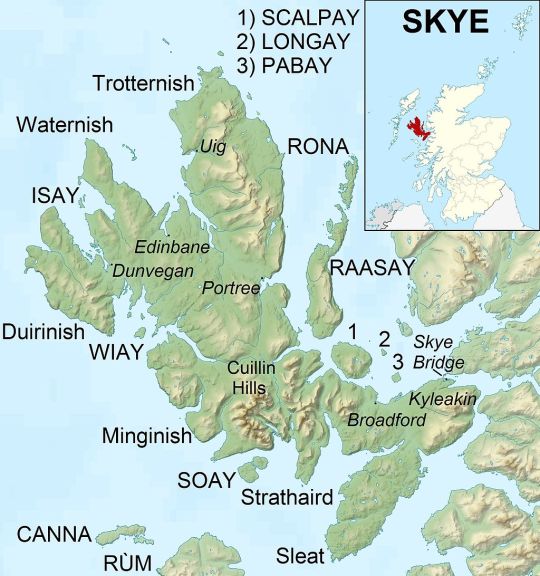
Skye is absolutely gorgeous by the way. The most iconic landmarks are probably the Old Man of Storr (left) and the Fairy Glen (right).
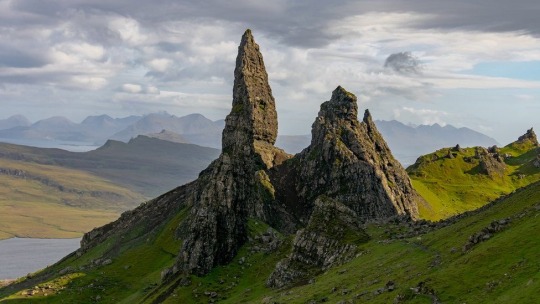

Unfortunately the stone circle was made in the modern day to encourage tourism (or… maybe Rowena made it back in the day for some witchcraft purpose?) but the ruined building overlooking the glen, Castle Ewan, is real and very vibey. Even if there’s not much left.
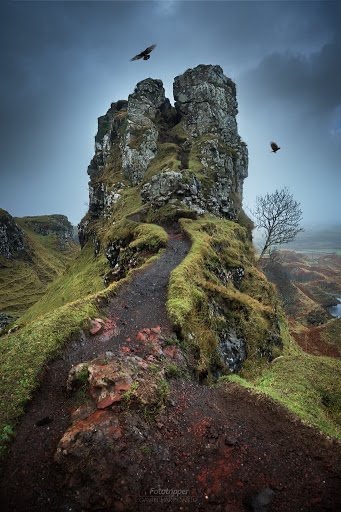

There are two main branches of Clan MacLeod: the MacLeods of Harris and Dunvegan, and the MacLeods of Lewis and Raasay. I personally like to imagine Crowley and Rowena as belonging to the first branch, since to this day they hold the seat of the Chief of Clan MacLeod, Dunvegan Castle.
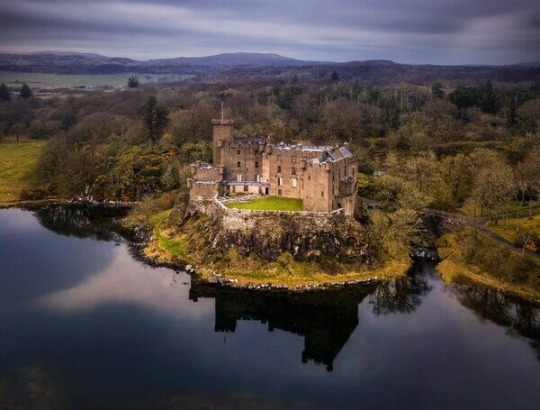

I just like the idea of either Rowena or Crowley pulling some strings and getting the castle for themselves in some fashion. Though I imagine if they did, they would definitely spruce up the interiors a bit.


Something that’s neat about the Dunvegan MacLeods is its heirlooms! These traditionally belong the the chief and are said to have various magical powers. The Fairy Flag is said to have the power to save Clan MacLeod from certain doom when unfurled. There’s also the silver Dunvegan Cup which dates back to the late 15th Century. Lastly is Sir Rory Mor’s horn. There’s fun lore for all of these items which could totally complement Rowena and Crowley’s characters. I won’t carry on about it on this post for the sake of post length, but feel free to look them up!
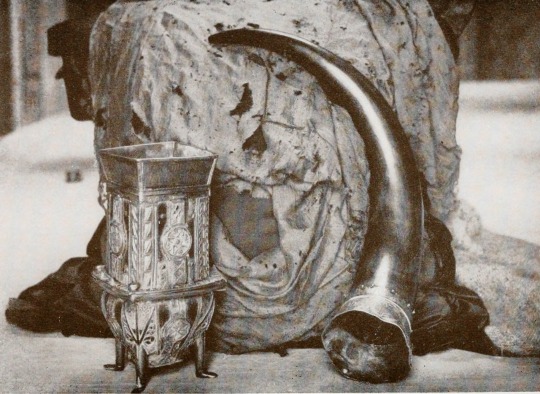
Something that’s NOT neat about the Dunvegan MacLeods is that, at least under Chief Norman MacLeod, they were royalists who fought against the Jacobite Uprising of 1745. The Lewis and Raasay MacLeods fought for the Jacobites at Culloden, though. I think Rowena would have definitely have been a Jacobite, so she might’ve defected to the other MacLeods or just struck out on her own to fight against the English for Scotland.
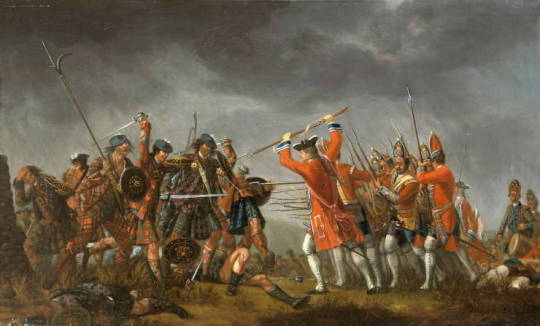
MacLeod Tartans
Contrary to popular belief, the history of tartans and their historical use in Highland clans isn’t as cut and dry as people tend to think. It’s a complicated history rife with misinformation and revisionism and forgery that I won’t get into right now, but suffice it to say that the vast majority of today’s tartans—definitely not all, but most—are actually modern inventions from circa the 19th Century.
Thankfully, both Crowley and Rowena made it to our modern day, meaning they can wear any of Clan MacLeod’s current registered tartans with no historical accuracy issues! The two most easily recognised MacLeod tartans are these:

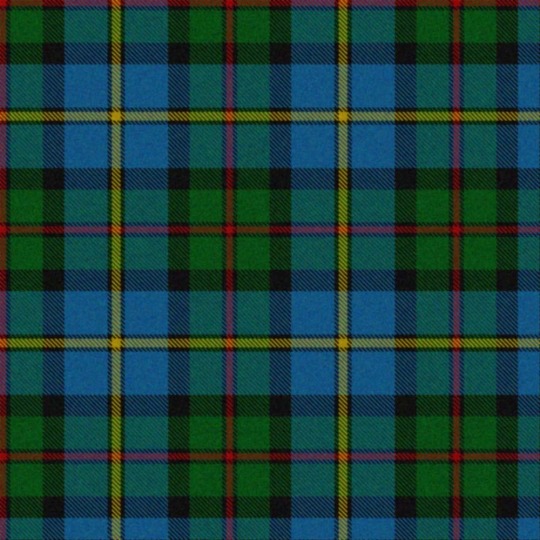
The yellow one on the left is the most iconic, most associated with the Dunvegan MacLeods. It’s sometimes called the “Loud MacLeod” tartan and is definitely the more modern of the two.
The blue-green one on the right is the MacLeod hunting tartan, which is probably more historically accurate relative to the Loud MacLeod, since it’s derived from the historical tartan of Clan MacKenzie.
Like I said though, regardless of historicity, both of these are recognised and worn as kilts, dresses, skirts, and sashes by MacLeods in the modern day!
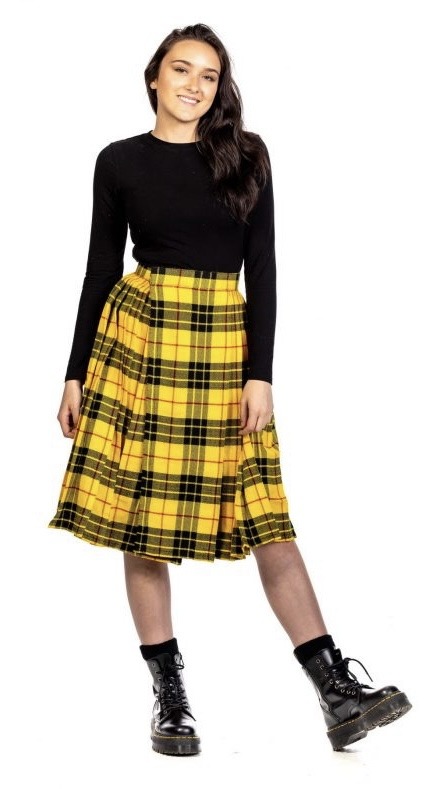
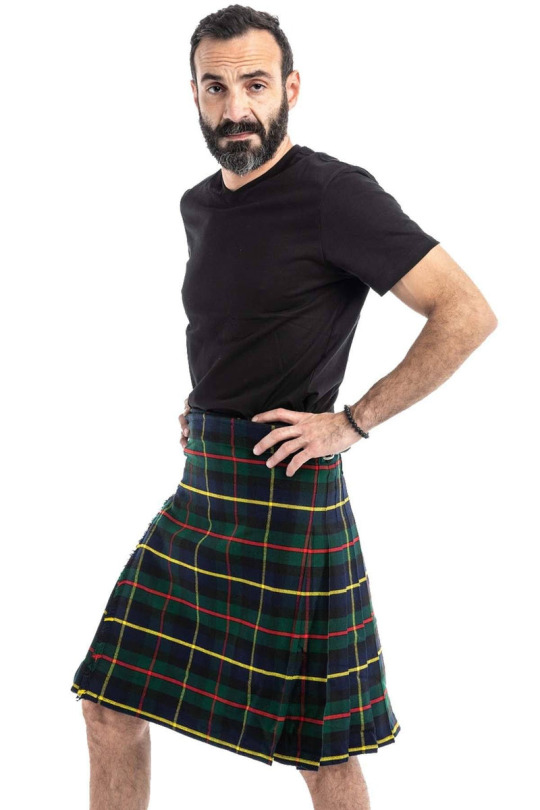
MacLeod Symbols
Other than tartan, Highland clans make use of a variety of symbols to represent their allegiance. This includes the clan crest, clan motto, and the clan badge.
The crest serves as the clan’s insignia—you can think of it like a coat of arms, which uses similar imagery. The crest will also display the clan’s motto. The crest of Clan MacLeod usually looks something like this:
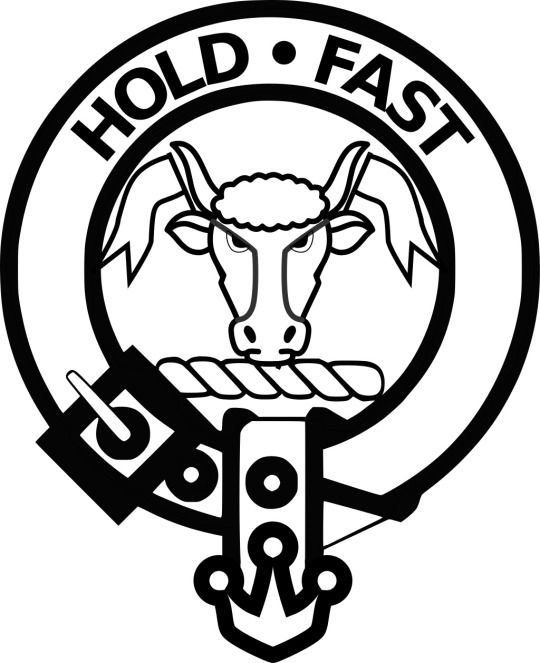
Clan MacLeod is represented by a bull’s head flanked by banners. Its motto is “Hold Fast”. I really like the stalwart message of the MacLeod crest and motto together, and it feels like you could connect it to such stubborn characters as Crowley and Rowena in really interesting ways.
The clan badge takes the form of a sprig of a certain plant associated with the clan. Clan MacLeod’s badge is juniper!

And what I REALLY adore about juniper being Clan MacLeod’s badge is this delightful bit of irony:

Evil spirits! Demons, even. I think this also connects to Crowley and Rowena in a very neat way.
And that’s the basics of Clan MacLeod for you! And it’s all I have for now. I hope to make more posts like this in the future exploring traditional Scottish dress, Scottish history during Rowena and Fergus’ time, and maybe even some common Scottish slang and Scots Gaelic phrases you might want to slip into Rowena or Crowley’s dialogue when you write. So stay tuned for more! Tìoraidh!
#Crowley spn#Rowena MacLeod#spn#My posts#Just thought I would offer this for anyone interested!#I really wish spn had literally any Desi characters so that I could do posts for the other half of my heritage too but alas#Still! I hope people find this kind of stuff useful to their creations#We need more Scottish Crowley and Rowena content!#Scotlandnatural
10 notes
·
View notes
Text
songs only come in three kinds
1. love song
2. let’s party
3. folk tune from the jacobite uprisings of 1745 mocking the english general john cope for his defeat at the hands of the highlanders in the battle of prestonpans, also known as the battle of gladsmuir, a much more fitting title when you consider the prophetic words of thomas the rhymer, in gladsmuir shall the battle be—
#very normal wake up playlist I have.#only four of the songs are about the Jacobite uprising#music#folk songs#folk music#shaoniposting
4 notes
·
View notes
Text


Brigadier General Hugh Mercer died on January 12th 1777 after being wounded at the Battle of Princeton.
Historians argue that, had it not been for his untimely and grisly death at the Battle of Princeton in 1777, Hugh Mercer, born in Aberdeenshire, would have been a greater leader than Washington and would rank as one of the greatest American heroes of all time.
Born on January 17h, 1726, at the manse of Pitsligo Kirk in Roseharty, Scotland, Hugh Mercer was the son of Reverend William Mercer and his wife Ann. At the age of 15, he left home to attend Marischal College at the University of Aberdeen to study medicine. Graduating as a doctor, he practiced locally until the arrival of Prince Charles Edward Stuart and the beginning of the 1745 Jacobite Uprising.
Rallying to the Prince’s colours, Mercer became an assistant surgeon in the Jacobite Army. He remained in this service until the Battle of Culloden. Mercer was forced to flee Scotland for America in 1747. Arriving in Philadelphia, he settled on the Pennsylvania frontier and returned to practising medicine. by 1758 he was, like many Scots who fled, serving in the British army, battling Shawnee and Delaware Indians, Mercer and his men took part in Lt. Colonel John Armstrong’s raid on Kittanning on September 8th, 1756. and became separated from his men. Alone following the battle, he made his way 100 miles on foot back to Fort Shirley where he received medical attention and was heralded a hero and promoted to the rank of Captain, it was here that Mercer was to become good friends with a man that would shape the remaining years of his life, also a Colonel at the time, his name was George Washington.
Before you start questioning his loyalty with being in the British army remember Washington was also in their pay at this time. After the 7 year war he settled back into private practice but 15 years later was elected as a Colonel of the Minute Men of Spotsylvania a Militia that would play an important part in the American Revolution, he had initially excluded from the elected leadership and branded a “northern Briton,” later being appointed Colonel in the Virginia Line part of the Continental Army which rose in revolt against British rule after the outbreak of the American Revolutionary War, once again he was fighting against “the auld enemy”.
One of the officers under Mercer was future president James Monroe. He rode through the ranks to Brigadier General distinguishing himself and involving himself with George Washington battle plans until January 3rd while on their way to The Battle of Princeton leading a vanguard of 350 soldiers, Mercer’s brigade encountered two British regiments and a mounted unit. A fight broke out at an orchard grove and Mercer’s horse was shot from under him. Getting to his feet, he was quickly surrounded by British troops who mistook him for George Washington and ordered him to surrender. Outnumbered, he drew his saber and began an unequal contest. He was finally beaten to the ground, then bayoneted repeatedly—seven times—and left for dead.
When Washington learned of the British attack and saw some of Mercer’s men in retreat, he himself entered the fray. Washington rallied Mercer’s men and pushed back the British regiments, but Mercer had been left on the field to die with multiple wounds to his body and blows to his head. (Legend has it that a beaten Mercer, with a bayonet still impaled in him, did not want to leave his men and the battle and was given a place to rest on a white oak tree’s trunk, while those who remained with him stood their ground. The tree became known as “the Mercer Oak” and is the key element of the seal of Mercer County, New Jersey.
When he was discovered, Mercer was carried to the field hospital in the Thomas Clarke House (now a museum) at the eastern end of the battlefield. In spite of medical efforts by Benjamin Rush, Mercer was mortally wounded and died nine days later on January 12, 1777.
In 1840 he was re-buried at Philadelphia’s Laurel Hill Cemetery. Because of Mercer’s courage and sacrifice, Washington was able to proceed into Princeton and defeat the British forces there. He then moved and quartered his forces to Morristown in victory.
The second picture show a painting entitled George Washington at Battle of Princeton features in the foreground Hugh Mercer lying mortally wounded in the background, supported by Dr. Benjamin Rush and Major George Lewis holding the American flag. This portrait is the prize possession of Princeton University.
16 notes
·
View notes
Note
Talk to me about Sirius the Jacobite
OKAY SO
i don't claim to be an expert in British history or Catholicism (if someone wants good Catholic history i'd recommend, well, YOU), but the parallels here are too strong for me to ignore.
So.
The International Statute of Secrecy was passed in 1689, according to Pottermore. JRK has offered a FEW reasons for this. Notably, the Salem Witch Trials, as well as a delegation of wizards being rejected by William and Mary after asking for protection from the monarchy.
Sooo, this is interesting, because BOTH of those things happened AFTER 1689. They happened in '90 and '92, when the Statute went fully into effect. So what happened in 1689?
Obviously this is going to be really obvious to anyone who went to school in England, but like, Americans don't learn anything about the history of most other countries. So maybe this will be helpful to other Americans, or to people from *any* country where they don't learn about British history.
in 1689, there was the "Glorious Revolution" in England. James II had only ruled for three years, but what made this REALLY important is that he was the last Catholic King of England. In fact, after 1689, there was a law in the Bill of Rights that there COULD be no more Catholic Monarchs, nor could a reigning monarch marry a Catholic. So we have this connection between wizards going underground and vanishing from public life at the same time Catholics finally lost power for good.
Also, much like with a religious schism, persecution was going strong with wizards, but there's no real way to TELL if someone is a wizard/religion, except by invading their private space and seeing tools of the trade. There were many secret Catholics who feared the reign of William and Mary, who succeeded after James II, and they pretended to be Protestant. There's a ton of hunting and violence and persecution, both ways (Protestants -> Catholics and Catholics -> Protestants) over the years depending on who was in power.
We know there was close linkage between the (Catholic) Monarchy and wizards - Lucius Malfoy I attempted to marry Elizabeth I, and Armand Malfoy came over from France with William the Conqueror as far back as 1066. There's also the connection between the Arthuriana link (Merlin is apparently a Slytherin) and religion, as in many versions of the Arthur myth, Catholicism plays a large role.
So as soon as the last Catholic King is defeated, wizards go underground.
Sirius mentions that Walburga thought that "being a Black made you practically royalty." What if he's not being facetious?
James II wasn't KILLED during the Glorious Revolution. In fact, he fled to France, and led several unsuccessful attempts to retake the crown, and so did a few of his descendants, in 1715 and 1745/46. But I'm not focusing on the uprisings: I'm focusing on the fact that there were, in fact, several entire communities of secret Catholics who dreamed of returning him to the throne. They were called Jacobites.
Catholic ritual and iconography lends itself much more strongly to a connection with magic than Anglican does. It makes sense that the Wizarding World, at least in the UK, would be primarily aligned with Catholicism. Maybe there were a lot of "ceremonies" and "miracles" that had a lot to do with wizards and magic. Maybe that was a good way for them to hide themselves, or maybe there was some service they were rendering to the bishops that helped them with defense and permissiveness.
So, I don't think it's farfetched to think that there's a marriage and bloodline connection between the Blacks and the Stuarts. And with wizards being so long-lived, plenty of them would have kept that tradition alive. The Black Family traces back to the Middle Ages (likely coming over with William also), and their family crest, Toujours Pur, is in French - like where James II fled to, where he had many family connections.
I wish we got a family tapestry that went farther back!!
14 notes
·
View notes
Text
Outlander and The Flight of the Heron: Parallels
[warnings for spoilers, as well as reference to sexual assault]
It should come as no surprise to anyone who is vaguely familiar with both Outlander and The Flight of the Heron that there are parallels between the two series. The author of Outlander has apparently read Flight (at least according to one source I came across on the internet) and although she credits her inspiration for Jamie Fraser to Jamie McCrimmon from Doctor Who, I find the similarities between Ewen Cameron and Jamie Fraser noteable. This is not to say that Diana Gabaldon lifted characters wholesale — Outlander, though arguably in parts derivative, has a fairly unique story in terms of its plot device of time travel, and while I personally have some issues with the series I nonetheless appreciate that its unique take on historical romance. With that in mind, however, I would like to lay out a number of similarities I have found between the two main characters in The Flight of the Heron and Outlander, though I would stress that these are only things I have noticed, and that there’s a greater argument to be made that Flight itself conforms to established tropes about the 1745 Uprising. I should also state that I do not have the Outlander series to hand, and although I have, when possible, consulted with the books in addition to the television series, I cannot verify specific page numbers.
Note as well that I use the term ‘Hanoverian’ rather than ‘British’ when talking about the British Army at the time — the Jacobite Rising was not, as is sometimes portrayed, about Scotland vs England, but was in many respects a revolution more in line with the Glorious Revolution of 1689, and therefore the Jacobite Army was, in a sense, the British Army, as Prince Charles Edward Stuart was considered by Jacobites as the proper Prince of Wales and heir to the British crown.
Ewen Cameron:
Born 1719, aged 26 in 1745
Described as some inches over six feet with thick auburn hair and deepset blue eyes
Chieftain of a cadet branch of Clan Cameron, Laird of Ardroy
An ardent Jacobite
Seriously injured in the thigh at the Battle of Culloden and left for dead
Escaped the fate of other wounded Jacobites on the field after his two foster brothers took him to safety in a local farmhouse (this may or may not be a historical detail, so I will reserve judgement on this point)
Formed an unlikely bond with a Hanoverian officer, Captain (later Major) Keith Windham, who felt an uneasy attraction to Ewen and who ultimately professed his feelings of friendship
Avoided death by firing squad only by the last minute intervention of a Hanoverian officer, Major Windham, who owed a debt of honour to Ewen
Very nearly subjected to flogging at the hands of a cruel Hanoverian officer, later imprisoned for several months in Fort Augustus before ultimately escaping to France
Personality: Ewen is a very gentle and considered man who beneath the surface is rather stubborn and hotheaded. He possess a strong sense of honour and duty.
James (Jamie) Fraser:
Born 1721, aged 24 in 1745
Described as being tall, 6′4″ according to the Outlander Wiki, with red or auburn hair and cat-like blue eyes
Chieftain of a cadet branch of Clan Fraser, Laird of Broch Tuarach
Fights for the Jacobite cause, however his loyalty to it is questionable as he does attempt to prevent the Rising after learning about its devastating effects from his wife, Claire, who is a time-traveller, and even goes so far as to consider murdering Prince Charles Edward Stuart
Seriously injured in the thigh at the Battle of Culloden and left for dead
Formed an antagnoistic bond with a Hanoverian officer, Captain “Black” Jack Randall, who is attracted to Jamie and goes so far as to sexually assault him
Formed an unlikely bond with a Hanoverian officer, Major John Grey, who felt a romantic attraction to Jamie and who made overtures to Jamie, which are rebuffed. They remained friends, however, despite the lack of romantic attraction on Jamie’s side
Escaped the fate of other wounded Jacobites on the field after two of his kinsmen took him to safety in a local farmhouse
Avoided death by firing squad only by the last minute intervention of a Hanoverian officer, Major Hal Grey, brother to John Grey, whose family owed a debt of honour to Jamie
Subjected to flogging at the hands of a cruel Hanoverian officer, Captain Randall, and was imprisoned on and off throughout his young adulthood, both before and after the Rising
Personality: Jamie is a charming and amiable man who also possesses a very stubborn and hotheaded side. He, like Ewen, possess a strong sense of honour and duty, although this was not uncommon for men of the 18th century, at least in fiction.
There are arguments to be made as well for the similarities between Keith Windham and Jack Randall and John Grey, with Randall sharing physical similarities with Windham (beind described as dark haired with hazel eyes), and Grey having a similar personality, as both Grey and Windham uphold their honour above all else, though they are occasionally rash. It may also be worth considering that John gives Jamie a sapphire ring at one point as a token of their friendship, just as Keith gave Ewen his signet ring as a memento of their friendship as he lay dying. I do want to stress, however, that I don’t believe that Gabaldon deliberately lifted from The Flight of the Heron, despite the many character similarities, although I would be curious to know how much she has read the book or the series, and if she is at all conscious of the possible mark it left on her own writings.
#the flight of the heron#meta#not tagging this as O*tlander because I don't want people to feel like I'm shitting on their series#because I'm very much not — there's plenty in the books I think is compelling
10 notes
·
View notes
Text
Isaac states to Pete in part 1 of the Christmas Spirit that Christmas 2022 will be his 280th one. If you do the maths then he was born in 1742. That means he would be alive during the 1700s part of outlander as it begins in 1743. Outlander deals with the 1745 Jacobite Uprising. Assuming Nigel is in his 30s when he died in 1777, it means he was also born in the 1740s. Therefore Nigel’s father could of fought in the 1745 Jacobite Uprising while in the British Army.
7 notes
·
View notes